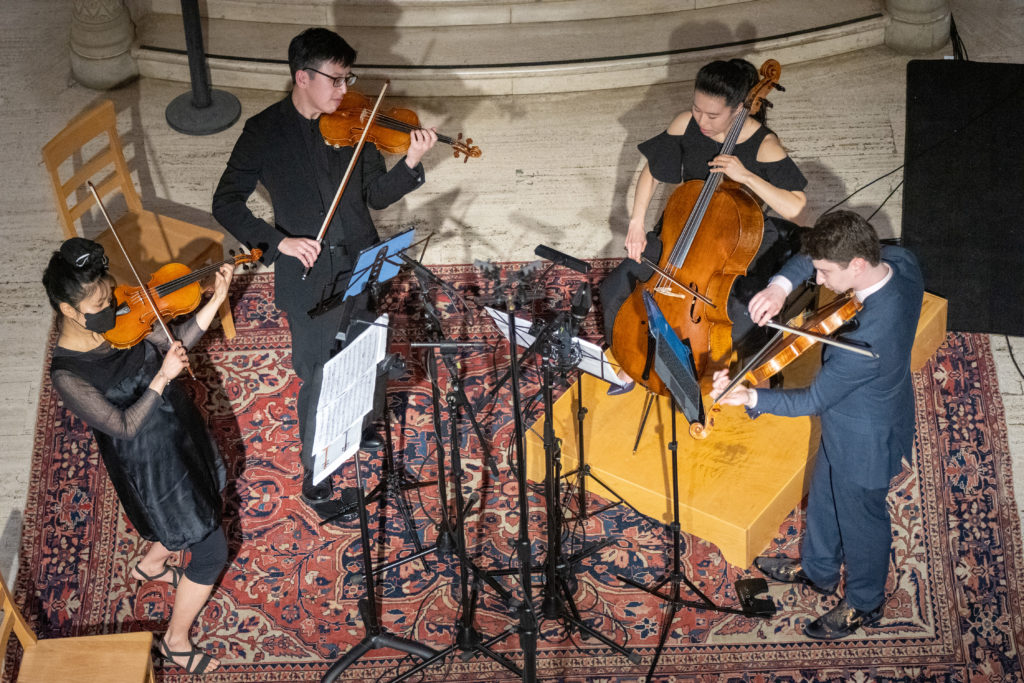The Formosa Quartet Plays Both For and With the Art of Elan Audience
Now in its 16th season, the chamber music series Art of Elan has cultivated an extremely loyal following. On a chilly, rainy Wednesday evening, an eager audience filled the San Diego Museum of Art’s spacious atrium to experience another program in Art of Elan’s 2022-2023 Landscapes series.

Formosa Quartet (l. to r.) Jasmine Lin, Wayne Lee, Deborah Pae, Matthew Cohen [photo (c.) Gary Payne]
Executive and Artistic Director Kate Hatmaker has indeed found a way to make chamber music simultaneously edifying and great fun.
From the printed program notes we learn that Michael Oesterle’s dozen movements of Parlour Games may be played in any order or any combination, according to the performers’ choosing. Double bassist Jeremy Kurtz-Harris and cellist Andrew Hayhurst selected five movements played in alternating fast and slow tempos, which made a satisfying suite. J. S. Bach proved that a clever, well-wrought two-part invention can be as exciting as a six-voice fugue, and Oesterle brought Bachian ingenuity to his agile counterpoint for the two lowest members of the string family.
From vivacious perpetuo motion figures in the opening movement to dissonant upper register close harmonies in one of the slow movements, the composer provided captivating, nimble polyphony that revealed the virtues of each instrument. The warm, deftly balanced sonorities of each player matched beautifully, from the resonant vibrations of Kurtz-Harris’ lowest register to the lyrical allure of Hayhurst’s highest range.
Hayhurst treated Einaudi’s Canto as a gentle rhapsody, in which fragments of melody slowly emerged from rocking, minimalist figurations. He crafted a spacious, almost sensuous melodic stream that filled the museum atrium with comforting solace.
In contrast to the title of Derrick Skye’s American Mirror title, the portion of the work played by the Formosa Quartet is based on classical Indian rhythmic and melodic traditions, and it also involves clapping by both the performers and members of the audience to flesh out its sharply defined rhythmic contours. Before the work began when Formosa Quartet violist Matthew Cohen was teaching the audience its own clapping patterns and accompanying gestures, I was filled with apprehension. To get an audience at a classical music performance to do anything together but listen attentively is a massive challenge.
Yet, towards the end of Skye’s virtuoso composition for string quartet—in which various quartet members had already engaged in much intermittent complex rhythmic clapping—when Cohen signaled the audience to do its part, they responded with such clean precision that I sat in astonishment!
I was not astonished at the Formosa Quartet’s commanding performance of Skye’s quartet: from first violinist Jasmine Lin’s bravura flourishes to second violinist Wayne Lee’s lithe cantabile lines, to Cohen’s bold solos and cellist Deborah Pae’s burnished, inviting bass lines. Their performances with Art of Elan in 2015 and 2016 were most impressive, and their return is truly welcome.
In American Roadmap, composers chosen by the Formosa Quartet have taken iconic songs from various popular traditions and expanded them into persuasive adventures for string quartet. Colin Jacobsen’s arrangement of the classic Appalachian fiddle tune “Little Birdie” takes the players on an exhilarating folkloric trip. Dana Wilson’s sultry version of W. C. Handy’s “St. Louis Blues” allows the upper strings to slither along the tune like a seasoned blues singer while the cellist supplies a swaggering pizzicato bass line.
David Balakrishnan’s highly animated interpretation of Dizzy Gillespies’ classic “A Night in Tunisia” includes a fantastic extended double cadenza for the first violin and cello, while Jeremy Crosmer’s short Motown tribute captures the pulsing spirit of “Ain’t No Mountain” by Nickolas Ashford and Valerie Simpson.
This concert was presented by Art of Elan at the San Diego Museum of Art in Balboa Park on Wednesday, March 15, 2023.

Ken Herman, a classically trained pianist and organist, has covered music for the San Diego Union, the Los Angeles Times’ San Diego Edition, and for sandiego.com. He has won numerous awards, including first place for Live Performance and Opera Reviews in the 2017, the 2018, and the 2019 Excellence in Journalism Awards competition held by the San Diego Press Club. A Chicago native, he came to San Diego to pursue a graduate degree and stayed.Read more…

A wonderfully exciting concert!
fantastic concert. kate is so welcoming—a wonderful role model!